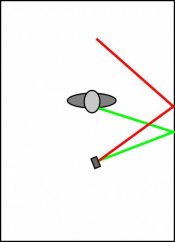Hello!
I have another newbie question for you guys.
I've just bought a Vivitar 2800 form my old film cameras. I'm trying to learn how to best use it. I soon had sucess bouncing the light off my living room ceiling. Then I tried bouncing the flash off a wall. A voice in my head told me it was not going to work. It in fact didn't but I just can't understand why.
I mounted the flash on my Olympus OM 2000 hot shoe. This flash model has a moving head. The head does not swivel, though I can set it at 90º, 75º, 60º and 0 degrees. Since the head doesn't swivel, I tried directing the flash at different angles towards the wall by holding the camera sideways (hope you can understand me now; English is not my native language). The problem is: I tried every aperture from 5.6 to 1.4 on the 50mm lens I was using. The negatives were all severely underexposed. The one shot at 5.6 was simply blank. The negatives shot with the flash pointing to the ceiling, on the other hand, looked quite all right. This is a mistery to me. I have tried both automatic and manual operation of the flash, to no avail.
Perhaps it has to do with the so-called thrystor. It's for some reason quenching the flash sooner than it should because the flash is not upright. I don't see why that should happen, though. Any ideas?
Thanks a lot!
Edimilson
I have another newbie question for you guys.
I've just bought a Vivitar 2800 form my old film cameras. I'm trying to learn how to best use it. I soon had sucess bouncing the light off my living room ceiling. Then I tried bouncing the flash off a wall. A voice in my head told me it was not going to work. It in fact didn't but I just can't understand why.
I mounted the flash on my Olympus OM 2000 hot shoe. This flash model has a moving head. The head does not swivel, though I can set it at 90º, 75º, 60º and 0 degrees. Since the head doesn't swivel, I tried directing the flash at different angles towards the wall by holding the camera sideways (hope you can understand me now; English is not my native language). The problem is: I tried every aperture from 5.6 to 1.4 on the 50mm lens I was using. The negatives were all severely underexposed. The one shot at 5.6 was simply blank. The negatives shot with the flash pointing to the ceiling, on the other hand, looked quite all right. This is a mistery to me. I have tried both automatic and manual operation of the flash, to no avail.
Perhaps it has to do with the so-called thrystor. It's for some reason quenching the flash sooner than it should because the flash is not upright. I don't see why that should happen, though. Any ideas?
Thanks a lot!
Edimilson


 )
)
